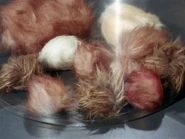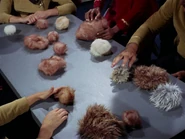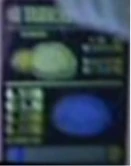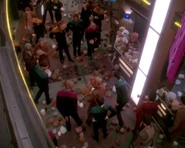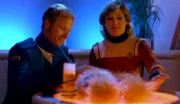No edit summary |
Tag: Visual edit |
||
| (38 intermediate revisions by 14 users not shown) | |||
| Line 1: | Line 1: | ||
| + | {{AlienSpecies |
||
| − | [[Image:Kirk_surrounded_by_Tribbles.jpg|thumb|250px|Captain Kirk and "some" Tribbles located on the Enterprise in 2268]] '''Tribbles''' (''Polygeminus grex'') are small, non-intelligent lifeforms originating from [[Iota Geminorum IV]]. Known for their prodigious reproductive rate, these round, furry creatures emit cooing sounds while touched, which have a tranquilizing effect on the Human nervous system. Born pregnant, with sufficient food a single tribble can quickly increase its number exponentially through presumably asexual reproduction, bearing an average litter of ten every twelve hours. On their homeworld, tribble populations are kept in check by a large number of reptilian predators. (DS9: "''The Nagus''"; TOS: "''The Trouble with Tribbles''") |
||
| + | |name = Tribble |
||
| + | |image = [[File:Kirk_surrounded_by_Tribbles.jpg|250px|Captain Kirk and "some" Tribbles located on the ''Enterprise'' in 2268]] |
||
| + | |universe = ''Star Trek'' |
||
| + | |world = Iota Geminorum IV |
||
| + | |length = ~ 10 to 30 cm |
||
| + | |diet = Herbivorous |
||
| + | |sapience = Non-Sapient |
||
| + | |behavior = Docile |
||
| + | |status = Used to be common; were temporarily wiped out by [[Klingon]]s but reintroduced to the timeline afterwards |
||
| + | }} |
||
| + | [[File:Tribble_crossection.jpg|thumb|250px|The inner workings of a Tribble]] |
||
| + | '''Tribbles''' (''Polygeminus grex'') are a species of small alien lifeforms which do little more than eating and reproducing constantly. These furry, rounded herbivorous creatures with no visible features come in several shades of brown, grey, cream, white or pink; can be from about ten to thirty centimeters long and move around by crawling rapidly or rolling. |
||
| + | ==Biology== |
||
| − | The homeworld and scientific name of the tribbles appeared on the chart in '''Keiko O'Brien's''' classroom on [[Deep Space 9]]. |
||
| + | Tribbles are physically harmless, but can be quite a problem due to their perpetual hunger and fast reproduction, as they reproduce asexually and are born pregnant. They emit purring sounds and are known to have a tranquilizing effect in the nervous system of [[Human]]s and possibly other species. [[Klingon]]s on the other hand detest Tribbles and consider them a nuisance and a pest; causing Tribbles to become scared and agitated whenever they approach a member of the Klingon species. Captain Kirk once took advantage of this and successfully used a tribble to identify a Klingon spy disguised as Human. |
||
| − | Tribbles were first encountered by Humans in the early 2150s, when '''[[Denobulan]] doctor Phlox''' [[http://memory-alpha.org/en/wiki/Phlox]] brought a small number aboard [[Enterprise NX-01]] as food for his pets. (ENT: "''The Breach''") |
||
| + | ==History== |
||
| − | The tribble was later encountered by the Federation aboard [[Deep Space K-7]] in 2268, when '''Cyrano Jones''' [[http://memory-alpha.org/en/wiki/Cyrano_Jones]] brought a small number aboard to trade. However, a single tribble brought aboard the [[USS Enterprise]] quickly multiplied to 1,771,561. The tribbles were instrumental in foiling a [[Klingon]] plan to poison a shipment of quadrotriticale intended for [[Sherman's Planet]], when tribbles that had fed on the grain were found dead. (TOS: "''The Trouble with Tribbles''") |
||
| + | The Tribble homeworld is called Iota Geminorum IV and is also home to reptilian predators which keep the population in check. Once off their homeworld, however, they can reproduce uncontrollably and become an invasive species. Genetic engineering was once used to attempt to make the tribbles safer by eliminating their ability to reproduce. At first, the affected tribbles appeared to be increasing in size, but it was soon discovered that they were still reproducing, but remaining together and forming tribble colonies. The situation was solved by Dr. McCoy, who found out that neo-ethylene would allow the tribble colonies to break apart and also cause the individual tribbles to have a slower metabolic rate. |
||
| + | In spite of this, in some point after these events the Klingons decided to end the tribble "pest menace" by bombarding the tribble homeworld, driving the species extinct. When the crew of space station ''Deep Space 9'' traveled to the past to prevent the assassination of James T. Kirk by a Klingon agent, they also managed to bring a few tribbles to the 24th century, successfully reintroducing the species. |
||
| − | At the same time, the crew of [[USS Defiant]], transported through time by '''Arne Darvin'''[[http://memory-alpha.org/en/wiki/Arne_Darvin]], prevented him from using a '''tricobalt device''' [[http://memory-alpha.org/en/wiki/Tricobalt_device]] hidden inside a tribble to kill '''James T. Kirk''' [[http://memory-alpha.org/en/wiki/James_T._Kirk]]. (DS9: "''Trials and Tribble-ations''") |
||
| + | ==Appearances== |
||
| − | Tribbles were an ecological menace for the Klingons, to whom a tribble would react violently. The Klingons first attempted to breed a predator to eliminate the threat. The [[glommer]] was used only once, in 2269, aboard the USS Enterprise, and proved unable to deal with the large number of tribbles aboard. (TAS: "''More Tribbles, More Troubles''") |
||
| + | *''Star Trek'' - "The Trouble with Tribbles" |
||
| + | *''Star Trek: The Animated Series'' - "More Tribbles, More Troubles" |
||
| + | *''Deep Space Nine'' - "Trials and Tribble-ations", ¨A Man Alone¨, and ¨The Nagus¨ |
||
| + | *''Star Trek Into Darkness'' |
||
| + | ==Gallery== |
||
| − | Information about tribbles was displayed by the computer in '''Keiko O'Brien's''' schoolroom on [[Deep Space 9]] in 2369. (DS9: "''A Man Alone''", "''The Nagus''") Tribbles were displayed in an LCARS graphic in one of the [[USS Enterprise-D]]'s science laboratories when the ship crash-landed on [[Veridian III]] in 2371. (Star Trek Generations) |
||
| + | <gallery> |
||
| + | Tribbles.jpg| |
||
| + | Tribbles02.jpg| |
||
| + | Tribblesgraphic2CGenerations.jpg| |
||
| + | DS9_Promenade_infested_with_tribbles.jpg| |
||
| + | Tribbles_on_Earth.jpg| |
||
| + | </gallery> |
||
| + | ==Notes== |
||
| − | Tribbles were reintroduced into the 24th century when '''Captain Benjamin Sisko''' and his crew brought at least one of the creatures back to 2373, following a time-traveling visit to the tribble-infested space station K-7 of 2268. The promenade and '''Quark's''' bar on Deep Space 9 were subsequently overrun with the creatures. According to Captain Sisko, the Federation's Department of Temporal Investigations was not told about the reintroduction of the tribbles because "they didn't ask". (DS9: "''Trials and Tribble-ations''") |
||
| + | *They are similar to the Martian [[Flat Cat]]s from Robert Heinlein's ''The Rolling Stones''. Writer David Gerrold, who created the Tribble species, was unaware of that at first, but when he found out about the book he asked for Heinlein's permission, which Heinlein granted in exchange for an autographed copy of the episode's script. |
||
| − | |||
| + | *In the book ''Evolving the Alien: The Science of Extraterrestrial Life'', a.k.a. ''What Does a Martian Look Like?'', Dr. Jack Cohen and Ian Stewart surprisingly elect the tribble one of the most realistic alien species in ''Star Trek'' and describe a thoroughly detailed alien ecosystem scenario to justify how such a creature could have evolved. |
||
| − | '''Miles O'Brien''' later recalled seeing the tribbles on the Enterprise with '''Julian Bashir''' when he was leaving Deep Space 9 at the end of the Dominion War. (DS9: "''What You Leave Behind''") |
||
| + | *The sounds of the tribbles came from altered dove coos, owl screeches, and empty balloons. |
||
| + | [[Category:Star Trek Universe]] |
||
| + | [[Category:Non-Sapient Species]] |
||
| + | [[Category:Wildlife]] |
||
| + | [[Category:Herbivores]] |
||
| + | [[Category:Lazarus Species]] |
||
| + | [[Category:Species Created by David Gerrold]] |
||
| + | [[Category:1967 Debuts]] |
||
| + | [[Category:TV Species]] |
||
| + | [[Category:Live Action Species]] |
||
| + | [[Category:Domesticable Species]] |
||
Revision as of 14:49, 29 May 2020
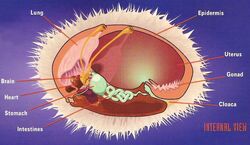
The inner workings of a Tribble
Tribbles (Polygeminus grex) are a species of small alien lifeforms which do little more than eating and reproducing constantly. These furry, rounded herbivorous creatures with no visible features come in several shades of brown, grey, cream, white or pink; can be from about ten to thirty centimeters long and move around by crawling rapidly or rolling.
Biology
Tribbles are physically harmless, but can be quite a problem due to their perpetual hunger and fast reproduction, as they reproduce asexually and are born pregnant. They emit purring sounds and are known to have a tranquilizing effect in the nervous system of Humans and possibly other species. Klingons on the other hand detest Tribbles and consider them a nuisance and a pest; causing Tribbles to become scared and agitated whenever they approach a member of the Klingon species. Captain Kirk once took advantage of this and successfully used a tribble to identify a Klingon spy disguised as Human.
History
The Tribble homeworld is called Iota Geminorum IV and is also home to reptilian predators which keep the population in check. Once off their homeworld, however, they can reproduce uncontrollably and become an invasive species. Genetic engineering was once used to attempt to make the tribbles safer by eliminating their ability to reproduce. At first, the affected tribbles appeared to be increasing in size, but it was soon discovered that they were still reproducing, but remaining together and forming tribble colonies. The situation was solved by Dr. McCoy, who found out that neo-ethylene would allow the tribble colonies to break apart and also cause the individual tribbles to have a slower metabolic rate.
In spite of this, in some point after these events the Klingons decided to end the tribble "pest menace" by bombarding the tribble homeworld, driving the species extinct. When the crew of space station Deep Space 9 traveled to the past to prevent the assassination of James T. Kirk by a Klingon agent, they also managed to bring a few tribbles to the 24th century, successfully reintroducing the species.
Appearances
- Star Trek - "The Trouble with Tribbles"
- Star Trek: The Animated Series - "More Tribbles, More Troubles"
- Deep Space Nine - "Trials and Tribble-ations", ¨A Man Alone¨, and ¨The Nagus¨
- Star Trek Into Darkness
Gallery
Notes
- They are similar to the Martian Flat Cats from Robert Heinlein's The Rolling Stones. Writer David Gerrold, who created the Tribble species, was unaware of that at first, but when he found out about the book he asked for Heinlein's permission, which Heinlein granted in exchange for an autographed copy of the episode's script.
- In the book Evolving the Alien: The Science of Extraterrestrial Life, a.k.a. What Does a Martian Look Like?, Dr. Jack Cohen and Ian Stewart surprisingly elect the tribble one of the most realistic alien species in Star Trek and describe a thoroughly detailed alien ecosystem scenario to justify how such a creature could have evolved.
- The sounds of the tribbles came from altered dove coos, owl screeches, and empty balloons.
